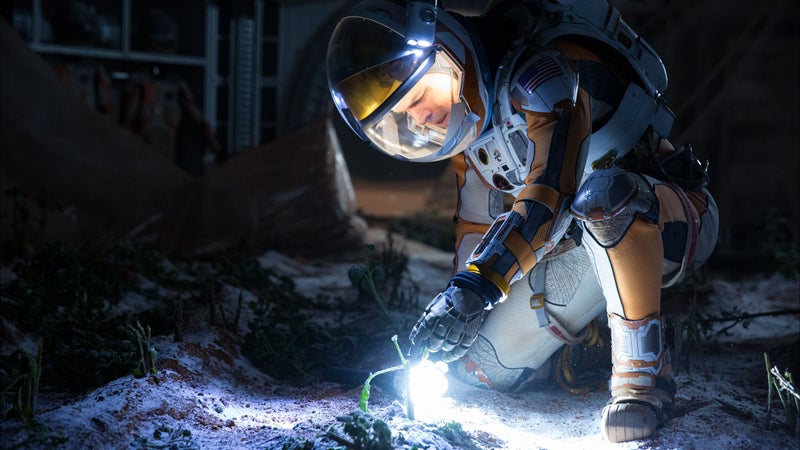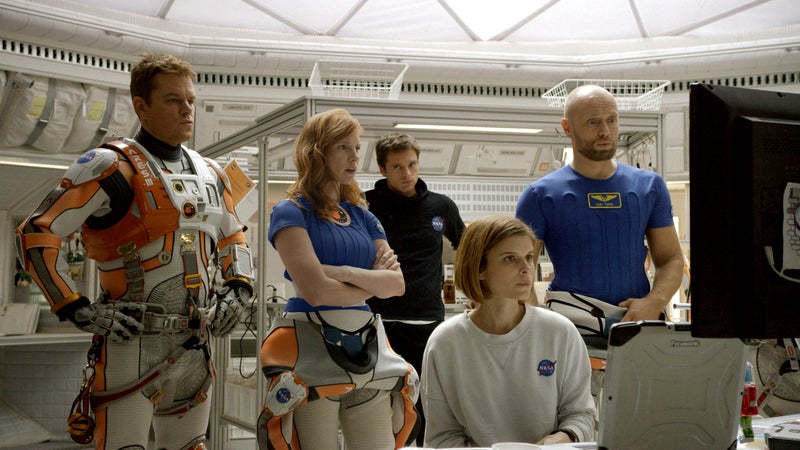Andy Weir’s novel The Martian has been widely praised for reigniting our enthusiasm for manned space exploration and for being scientifically accurate. Everything from the design of the “hab” occupied by the main character, astronaut Mark Watney, to the chemistry and engineering he employs to survive on the Red Planet is hailed as being grounded in fact.
That’s due in part to thousands of online readers who fact-checked The Martian when it was first published online, in 2011, as a free serialized novel. Aficionados were quick to point out inaccuracies, allowing Weir to revise and strengthen the credibility of his story before it was published as an ebook on Amazon and, later, in hardcover. One reader even used the orbital trajectories of the spaceship, Hermes, and future relative positions of Earth and Mars to figure out the unspecified dates during which the story takes place, which Weir confirmed in a Facebook post. (The initial launch date of Hermes is July 7, 2035.)
To apply the same scrutiny to the film, released on Friday, October 9, screenwriter Drew Goddard and director Ridley Scott consulted Weir as well as NASA engineers. “While they were filming, I would get questions filtered through intermediaries from Ridley about these deeply technical subjects,” Weir told Outside. Several of the situations portrayed in The Martian—both the book and the film, which follow nearly identical storylines—are fully accepted as being plausible: Watney pulling potable water from jet fuel, the orbital trajectory of the Hermes slingshot maneuver around the Earth, the design and functionality of the hab, for example.
But how accurate are some of the story's pivotal moments? To find out, we turned to advisors of our own: NASA's Jet Propulsion Lab mechanical engineers Michael Burger and Megan Richardson, who are working on future missions to Mars. If anyone would know how plausible Watney’s survival methods are, and how Mars’ surface systems function, it's these two. Warning: spoilers ahead.
The Storm: Impossible

A windstorm on the surface of Mars at the beginning of the film almost blows over the return spacecraft, forcing Watney’s fellow astronauts to launch without him. But a storm of that magnitude has never been recorded on Mars, Burger says. “The storm at the beginning could not have knocked over that spaceship,” he says. “You can get winds on Mars up to about 60 miles per hour, which sounds pretty fast, but the pressure is about 0.6 percent of what it is on Earth, and you need both the pressure and the wind to actually knock things over.” Meaning that the air on Mars isn't dense enough to blow over a craft like the Mars Ascent Vehicle (MAV).
The Punctured Suit: Likely
That windstorm slams a satellite dish into Watney, sends him flying down a hill, and drives a metal rod through his space suit and abdomen. The pinched angle of the rod and smattering of blood seal the suit enough to keep him alive. “I think it’s possible,” Richardson says. “That didn’t strike me as something completely unrealistic, but I wouldn’t want to try it.”
“It makes sense that if you have enough coagulated, congealed, stuck-together blood, it’ll be able to hold the pressure of whatever is inside the suit,” adds Burger.
Growing Crops: Unlikely

After Watney makes it back to the hab, he quickly realizes that he will need more food than the available rations to survive until the next crewed mission to Mars can rescue him some four years later. His solution: grow potatoes inside the shelter.
While Burger says that the low gravity on Mars—about 38 percent of Earth’s gravity—shouldn’t prevent crops from growing (we have successfully grown lettuce in zero gravity), Richardson suggests that high amounts of radiation on the Red Planet would pose a major problem to growing food. “I don’t think [the potatoes] would have gotten enough natural sunlight with the amount of radiation shielding that would be needed on the hab,” she says.
The Depressurization Chamber Blowing Off: Unlikely
Halfway through the story, Watney experiences his greatest setback since becoming stranded: after using the same airlock many times to enter and exit the hab, the depressurization chamber finally rips from the hab and launches through the air, with Watney inside.
“If you have a very small hole letting air out of a balloon, it will fly around like crazy,” explains Burger. “If you have a very large hole, it will just release a large puff of air and not go very far. I think when the hab blew up it would have blown out a very large hole. It would have been a problem, but I don’t think it would have gone flying.”
Duct-Taping A Space Helmet: Maybe
After bouncing around inside the blown-away decompression chamber, Watney’s faceplate cracks. He covers the hole in the glass with duct tape and dashes—outside—to the safety of the rover. “Duct tape probably would not work,” says Richardson. “In the book, [Weir] says that he had a patch kit with some special material and adhesive,” in addition to the duct tape.
But Burger thinks Watney would have a chance. “You don’t need one whole atmosphere [the measure of air pressure at sea level] of pressure inside of the suit to keep somebody alive. So if the pressure on the inside is pretty low and the tape is sticky enough, it would probably hold for a little while. I think it could happen.”
Astronaut Floating Around Outside of Hermes: Unlikely
At one point, as Hermes is returning to Mars to rescue Watney, we see astronaut Chris Beck outside the craft, bounding recklessly from one part of the ship to the next, without a tether and around rotating pieces of the ship, to get away from a bomb that the crew intentionally uses to decelerate.
“They would never ever do that,” laughs Burger. “They would never jump through some spinning object. They would always have a tether. Working in space is very slow and methodical. They don’t take any unnecessary risks.”
The Rescue Launch: Unlikely

Then there’s the issue of Watney’s eventual escape. After tricking out one of the rovers to drive more than a month to the next mission site (all correctly calculated), he uses the MAV, already set up for the next crewed mission to Mars, to launch off the planet and reunite, in space, with Hermes.
The problem the characters face is that Hermes used a gravitational slingshot around Earth to get back to Mars in time to save Watney’s life; and it is traveling too fast to enter Mars’s orbit. Watney strips the MAV down to the bare bones, even removing the nose cone and replacing it with extra canvass material, then launches the MAV to a much higher altitude than it was designed for to reach Hermes.
“That seemed very farfetched to me,” says Richardson. “I think he probably would have gone into some sort of uncontrollable spin. As the different things were blowing off, I feel like it wouldn’t have been as controlled, and he wouldn’t have gotten nearly close enough to his destination for them to reach out with a tether and grab him.”
But Burger thinks Watney might have a chance. “There was a project that I worked on for a little while that had a MAV [not for an astronaut to fly in], and we were messing with the idea of not using a nose cone to launch something into Mars orbit from the Martian surface. I’m sure people have looked into launching a MAV without a perfectly aerodynamic shape because of the low atmospheric pressure on Mars. I’m not entirely sure that it wouldn’t work.”
The ‘Ironman’ Stunt: Impossible
Even with a change of course from Hermes, the crew isn’t quite close enough to grab Watney, so he cuts a hole in the glove of his suit and uses the escaping pressure to “fly like Ironman.”
“You can have small portions of your body touching space for relatively long amounts of time,” says Burger. “Once, a guy on a spacewalk had a cut in his suit, and his skin got stuck to the outside of the spacesuit and was touching the vacuum of space. When he came back in, he was fine. But if you did that to your glove, your palm would get sucked to the hole and seal it up pretty fast. So I don’t think you would actually be able to use it like a jet.”
Verdict: Improbable
Overall, Richardson and Burger say that though many of the turning points of the story are farfetched, much of the technology in The Martian already exists or is being developed. As Richardson points out, the International Space Station is already equipped with a water reclaimer that can filter potable water from waste, and Mars 2020 will be equipped with an instrument to convert carbon dioxide into oxygen, similar to Watney’s oxygenator.
Even Pathfinder, the Martian lander that Watney digs up to communicate with Earth, looks exactly like the real probe that was launched to Mars in the mid-1990s. Says Richardson: “At one point I wondered if we actually sent them some hardware or some photos to work off of.”

